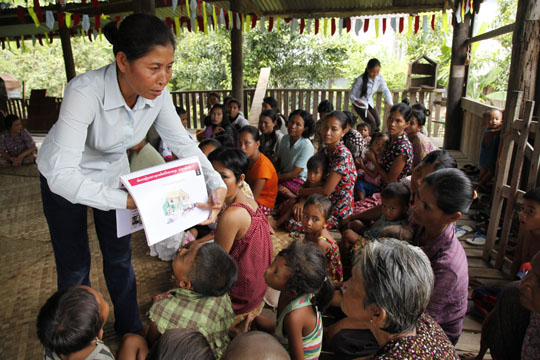Integration Works! Addressing Pneumonia and Diarrhoea in Cambodia
|

In August I attended the International Congress of Pediatrics, which was hosted in Melbourne, Australia. The Congress is a global meeting place of physicians, researchers, nurses and health care workers in the field of pediatrics and civil society partners. A key thematic area of the conference was addressing pneumonia and diarrhoeal disease - the two leading killers of children under five across the globe. Given the extensive experience of PATH Cambodia in terms of addressing childhood pneumonia and diarrhoea, we felt that engagement in this Congress would be critical.
With the support of the Advocacy and Public Policy (APP) team at PATH we developed a poster for presentation at the Congress. The poster, entitled Tackling Pneumonia and Diarrhoea Through Policy Integration and Community-Level Implementation, highlighted the integrated approach that Cambodia has adopted in terms of preventing and treating pneumonia and diarrhoea.
Since 1998, the Ministry of Health Cambodia (MoH) has integrated both diseases into one National Acute Respiratory Infection and Control of Diarrhoeal Disease Program (ARI/CDD Program) and made it a top priority in terms of addressing childhood morbidity and mortality. In collaboration with the Cambodia MoH, PATH implemented the Enhanced Diarrheal Disease (EDD) Initiative from June 2011 to August 2012. The programme, piloted in one district, consisted of a two-pronged approach to build the political will to strengthen policies related to diarrhoea and pneumonia, and then to implement a new integrated package of services within communities.
The Cambodian MoH was encouraged by the launch of the Global Action Plan for Pneumonia and Diarrhoea (GAPPD) by WHO and UNICEF in April 2013, which provides the global normative guidance supporting the integration of pneumonia and diarrhoea and calls on countries to adopt this approach. Cambodia is integrating the policies and programmes for pneumonia and diarrhoea and the results are being felt - Cambodia is on track to reach Millennium Development Goal 4 on reducing the levels of childhood morbidity and mortality and the efforts to address the leading killers of children under 5 has played a significant role in this success.
Partners at the Conference were highly interested in the integrated approach that has been adopted in Cambodia. Many participants came to ask how this had been rolled out, and what the results have been, and how this is working from an operational level. So many participants wanted to know how this could be replicated in their own countries and what the key lessons learned have been. I feel proud of what we have been able to achieve in Cambodia and excited that we can share the lessons learned and provide a model that could be used in other countries. I believe this model can be replicated and have a major impact of addressing these two diseases; strong political commitment, advocacy to create an enabling environment for policy integration and programme implementation, with a strong focus on community involvement and ownership, are some of the essential ingredients to making this a success!
For more information
- Fact sheet: Combining forces in Cambodia to overcome childhood diarrhea and pneumonia
- Case study: Tackling pneumonia and diarrheal disease through program and policy coordination: A case study of PATH's integrated approach in Cambodia
- Photo gallery: Cambodia 2011














